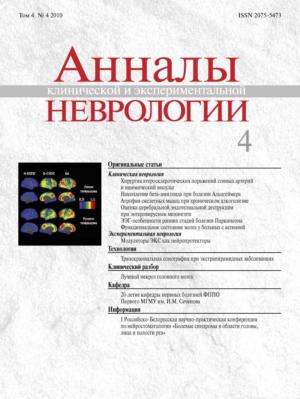Особенности функционального состояния мозга и когнитивных функций у больных вегетативной дистонией в сочетании с выраженной астенией
- Авторы: Гордеев С.A.1, Шварков С.Б.2, Ковров Г.В.2, Посохов С.И.2, Дьяконова Н.A.3
-
Учреждения:
- Научный центр неврологии РАМН
- Первый Московский государственный медицинский университет им. И.М. Сеченова
- Психоневрологический диспансер № 14 Департамента здравоохранения г. Москвы
- Выпуск: Том 4, № 4 (2010)
- Страницы: 31-36
- Раздел: Оригинальные статьи
- Дата подачи: 03.02.2017
- Дата публикации: 13.02.2017
- URL: https://annaly-nevrologii.com/journal/pathID/article/view/324
- DOI: https://doi.org/10.17816/psaic324
- ID: 324
Цитировать
Полный текст
Аннотация
Обследовано 26 больных вегетативной дистонией в сочетании с выраженной астенией и 22 здоровых испытуемых с использованием клинического, психометрического, нейропсихологического и электрофизиологического методов. В качестве электрофизиологических методик использовался компрессионный спектральный анализ ЭЭГ и метод связанных с событиями слуховых вызванных потенциалов Р300. В результате нейропсихологического исследования у больных было обнаружено нарушение избирательности, устойчивости, переключаемости внимания и снижение кратковременной памяти на слова и числа. Пациенты отличались от здоровых испытуемых достоверно более низкой амплитудой волны Р300, а также достоверно более низкими значениями спектральной мощности альфа-ритма в затылочных областях обоих полушарий, в задней лобной, центральной, теменной областях правого полушария и достоверно более высокими значениями спектральной мощности тета-колебаний в правой лобной, левой теменной и центральных областях обоих полушарий. Сделан вывод: изменения спонтанной и вызванной электрической активности мозга у больных с астенией отражают снижение общего уровня функциональной активности мозга вследствие нарушения регулирующих влияний лимбико-ретикулярных структур. В этом случае не обеспечивается достаточный уровень активации коры, необходимый для оптимального процесса переработки информации и обеспечения адекватного уровня направленного внимания и кратковременной памяти.
Об авторах
С. A. Гордеев
Научный центр неврологии РАМН
Email: gordeevSA58@mail.ru
Россия, Москва
С. Б. Шварков
Первый Московский государственный медицинский университет им. И.М. Сеченова
Email: gordeevSA58@mail.ru
Россия, Москва
Г. В. Ковров
Первый Московский государственный медицинский университет им. И.М. Сеченова
Email: gordeevSA58@mail.ru
Россия, Москва
С. И. Посохов
Первый Московский государственный медицинский университет им. И.М. Сеченова
Email: gordeevSA58@mail.ru
Россия, Москва
Н. A. Дьяконова
Психоневрологический диспансер № 14 Департамента здравоохранения г. Москвы
Автор, ответственный за переписку.
Email: gordeevSA58@mail.ru
Россия, Москва
Список литературы
- Боголепов Н.Н., Фокин В.Ф. Функциональная межполушарная асимметрия. Хрестоматия. М.: Научный мир, 2004.
- Вейн А.М., Дюкова Г.М., Воробьева О.В., Данилов А.Б. Панические атаки. М.: Эйдос Медиа, 2004.
- Гордеев С.А. Применение метода эндогенных связанных с событиями потенциалов мозга Р300 для исследования когнитивных функций в норме и клинической практике. Физиология человека 2007; 33: 121–133.
- Гордеев С.А. Психофизиологическое исследование внимания при астено-невротических расстройствах. Межд. неврол. журн. 2007; 1: 78–82.
- Горев А.С. Динамика ритмических составляющих ЭЭГ в условиях релаксации у школьников 9–10 лет с различной успешностью обучения. Физиология человека 1998; 24: 42–47.
- Ильюченок И.Р. Различия частотных характеристик ЭЭГ при восприятии положительно-эмоциональных, отрицательно-эмоциональных и нейтральных слов. Журн. высш. нерв. деят. 1996; 46: 457–468.
- Крейндлер А. Астенический невроз. Бухарест, 1963.
- Наатенен Р. Внимание и функции мозга. М.: Изд–во МГУ, 1998.
- Хомская Е.Д. Мозг и активация. М.: Изд-во МГУ, 1972.
- Hanaoka A., Kikuchi M., Komuro R. et al. EEG coherence analysis in never-medicated patients with panic disorder. Clin. EEG Neurosci. 2005; 36: 42–48.
- Hanatani T., Sumi N., Taguchi S. et al. Event-related potentials in panic disorder and generalized anxiety disorder. Psychiatry Clin. Neurosci. 2005; 59: 83–88.
- Ivan A.B., Polich J. P300 and response time from a manual Stroop task. Clin. Neurophysiol. 1999; 110: 367–373.
- Kropotov J.D., Ponomarev V.A. Subcortical neuronal correlates of component P300 in man. EEG Clin. Neurophysiol. 1991; 78: 40–49.
- Lissak K., Grastyan E., Molnar L. et al. Significance of the hypothalamus and hippocampus in the higher nervous activity. Cesk. Fysiol. 1957; 6: 461–466.
- Newton T.F., Leuchter A.F., Van Gorp W.G. et al. EEG power correlates with subcortical metabolic activity in AIDS. J. Neuropsychiatry Clin. Neurosci. 1997; 9: 574–578.
- Pauli P., Amrhein C., Muhlberger A. et al. Electrocortical evidence for an early abnormal processing of panic-related words in panic disorder patients. Int. J. Psychophysiol. 2005; 57: 33–41.
- Polich J., Kok A. Cognitive and biological determinants of P300: an integrative review. Biol. Psychol. 1995; 41: 103–146.
- Polich J., Squire L.R. P300 from amnesic patients with bilateral hippocampal lesion. EEG Clin. Neurophysiol. 1993; 86: 408–417.
Дополнительные файлы








